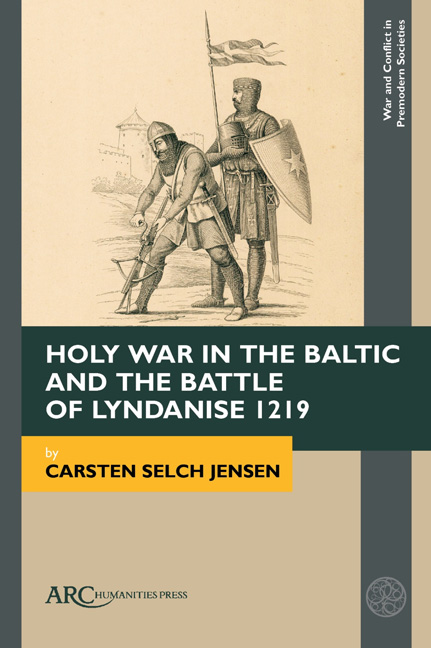Book contents
- Frontmatter
- Contents
- List of Illustrations
- Acknowledgments
- Introduction. Holy War in the Baltic and the Battle of Lyndanise 1219
- Chapter 1 Foreign Shores—Foreign People: The Medieval Baltic and its People
- Chapter 2 Fighting God’s War: Papal Crusading Politics in the Baltic from the Early 1100s until the Early 1200s
- Chapter 3 A Society Organized for War: Denmark at the Beginning of the Thirteenth Century
- Chapter 4 Competing Powers: The German Mission in Livonia and the Initial Quest for Estonia
- Chapter 5 Waging War in the Wilderness: Western Military Traditions Meet Baltic Traditions
- Chapter 6 The Danish Expedition to Estonia in 1219 and the Battle of Lyndanise
- Chapter 7 Conquering Hearts and Minds: The Aftermath of the Battle
- Conclusion A Penny in the Box: How Estonia Came to Save Denmark
- Select Bibliography
- Index
Introduction. Holy War in the Baltic and the Battle of Lyndanise 1219
Published online by Cambridge University Press: 08 May 2024
- Frontmatter
- Contents
- List of Illustrations
- Acknowledgments
- Introduction. Holy War in the Baltic and the Battle of Lyndanise 1219
- Chapter 1 Foreign Shores—Foreign People: The Medieval Baltic and its People
- Chapter 2 Fighting God’s War: Papal Crusading Politics in the Baltic from the Early 1100s until the Early 1200s
- Chapter 3 A Society Organized for War: Denmark at the Beginning of the Thirteenth Century
- Chapter 4 Competing Powers: The German Mission in Livonia and the Initial Quest for Estonia
- Chapter 5 Waging War in the Wilderness: Western Military Traditions Meet Baltic Traditions
- Chapter 6 The Danish Expedition to Estonia in 1219 and the Battle of Lyndanise
- Chapter 7 Conquering Hearts and Minds: The Aftermath of the Battle
- Conclusion A Penny in the Box: How Estonia Came to Save Denmark
- Select Bibliography
- Index
Summary
Having collected a very huge army King Valdemar set out for Estonia with one thousand five hundred longships (longis navibus), and having fought many bat-tles he eventually converted the entire country to Christianity subjugating it to Denmark as it still is.
SUCH IS THE brief mention in the medieval annalistic chronicle, Annales Ryenses, of the military conquest of Estonia in the early thirteenth century by Western (mostly Danish and German) crusaders and one of the pivotal events during the conquest, namely the Battle of Lyndanise 1219. While the chronicle is believed to have been com-pleted sometime around 1300, the actual battle mentioned in the text had taken place in Estonia some eighty years before: on an early summer's day in June a Danish force of crusaders led by the Danish King Valdemar II of Denmark (r. 1202–1241), and sup-ported by the Danish Archbishop of Lund, Anders Sunesen (r. 1202–1224, d. 1228), joined battle with an opposing force of local Estonian warriors led by their elders and war chieftains. As we shall see in this book, the battle was a hard-fought and brutal affair that nearly ended in a total Danish defeat. A series of chance events however completely changed the outcome of the battle and resulted, instead, in what seems to have been a total Estonian defeat—at least according to one (near) contemporary source. It was a defeat that enabled the Danes to firmly establish themselves (politically, militarily, and ecclesiastically) in the northernmost provinces of Estonia for the next almost one hundred fifty years, though they were sincerely challenged by strong ecclesiastical and military powers from German-controlled Livonia as we shall see in this volume.
From a military perspective and with all due consideration to the tactical and the strategical implications, the conquest of Estonia and the Battle of Lyndanise do not seem overly important in a general medieval setting. The Middle Ages saw countless other battles involving many more fighting men and resulting in outcomes that, in many more profound ways, decided the fate of great lords and entire nations. Not even among the many battles that took place in a distinct crusading setting does the Battle of Lyndanise stand out as something very spectacular or decisive.
- Type
- Chapter
- Information
- Publisher: Amsterdam University PressPrint publication year: 2024

